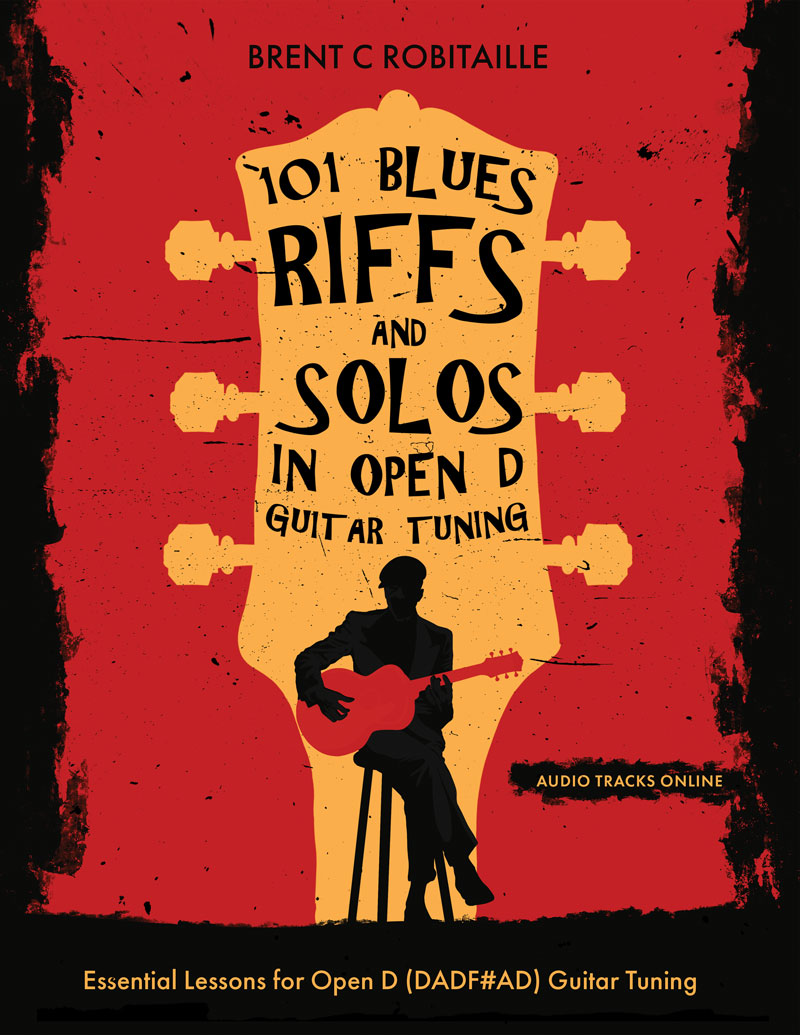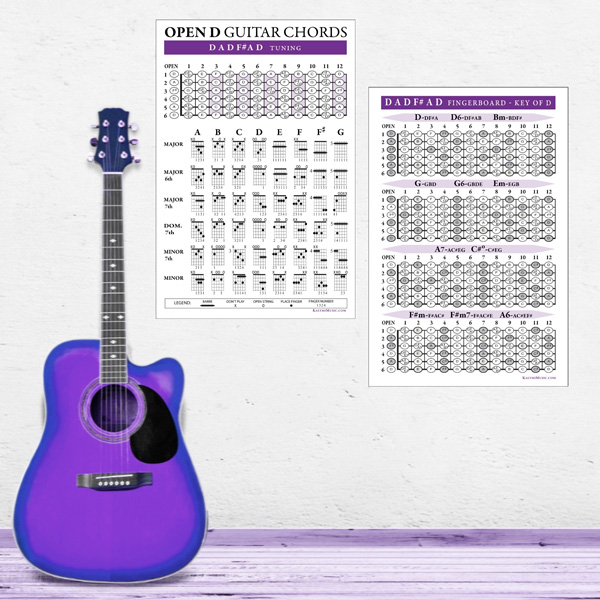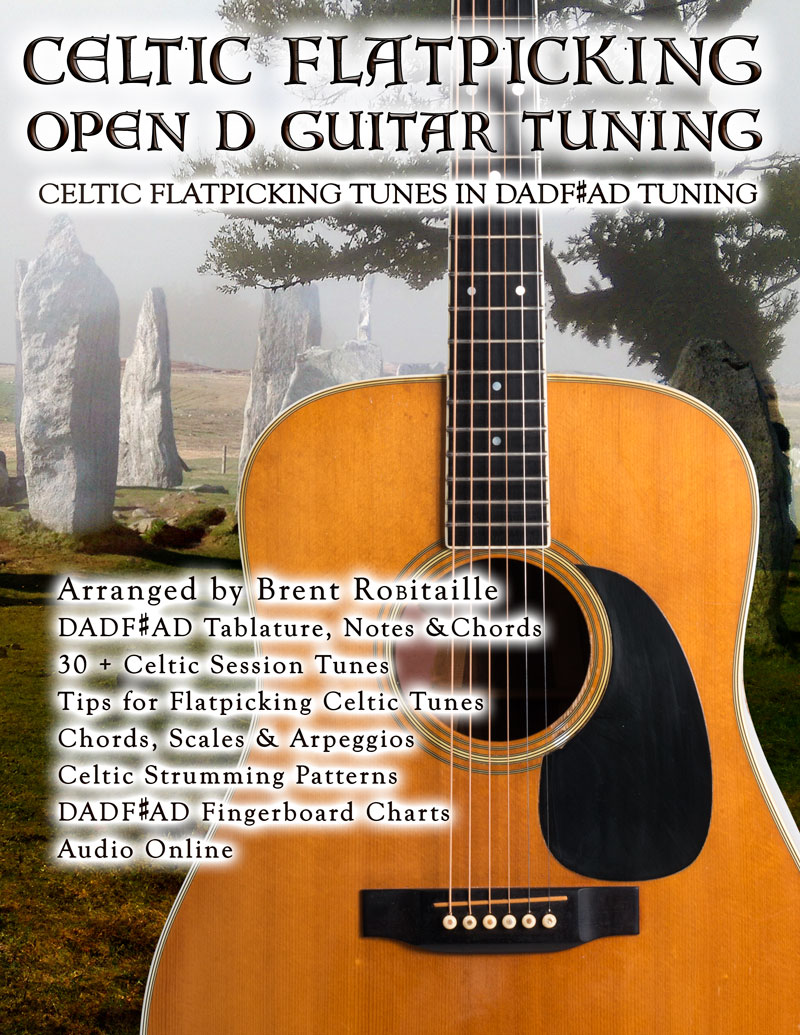In today’s lesson, we will make a simple 12 bar blues solo in the key of D using the open position blues scale in open D guitar tuning (D A D F# A D). Most guitarists can do this naturally in good old standard tuning after learning a few blues scales and then creating a few riffs.
You can turn a pro guitar player into a novice if they don’t know their blues scales in an altered tuning like Open D. So, let’s learn a few the blues scale in position one to start off. If you are new to Open D tuning check out this post for how to tune.
The Blues Scale in Open D
We will create our little 12 bar solo in the key of D as it is the easiest in this tuning. I mean, you are tuned to a D major chord after all! Here’s the blues scale in open position:
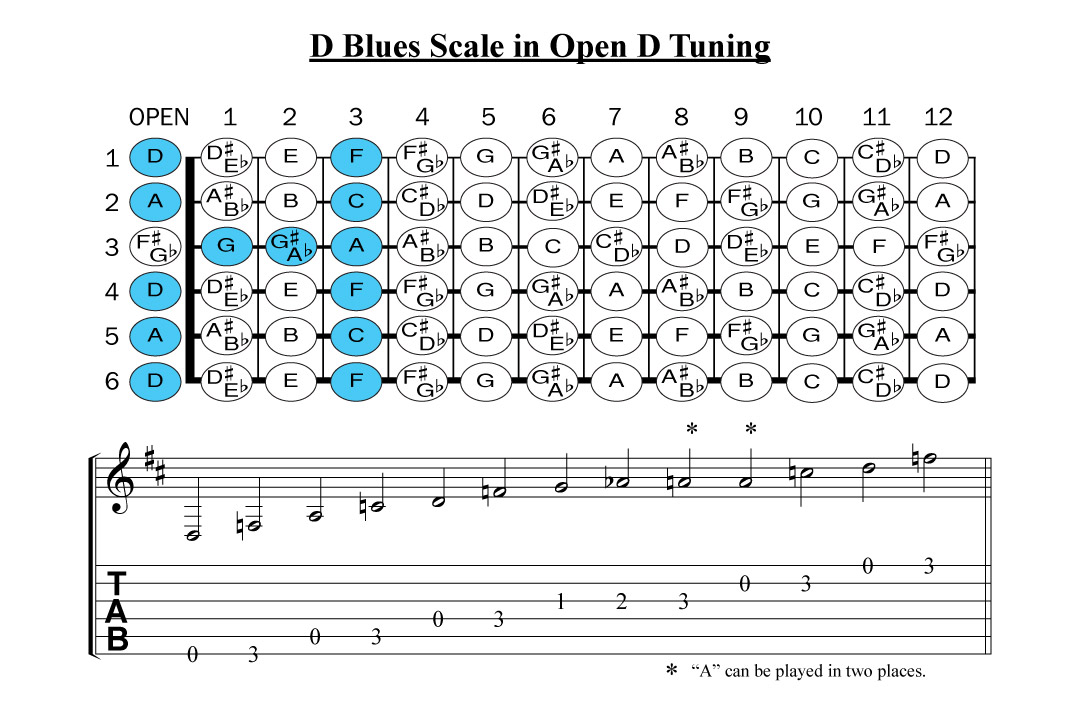
Ok, get that scale firmly in your hands, playing the notes up and down, playing with a straight and shuffle rhythm. To learn a 12 bar blues chord progression with Open D chords check out this post here.
Creating Riffs with the Open Blues Scale
Let’s move on to creating our first short blues riff. For tips on how to improvise and soloing check, the post 10 TIPS FOR IMPROVISING FLAWLESS MUSIC SOLOS.
I will take three riffs from my book “101 Blues Riffs in Open D Tuning” to make our 12 bar blues solo. The first riff is 2 bars long and uses a characteristic slide from the 2nd to 3rd fret with a triplet rhythm. Here’s riff 1 with the audio below:
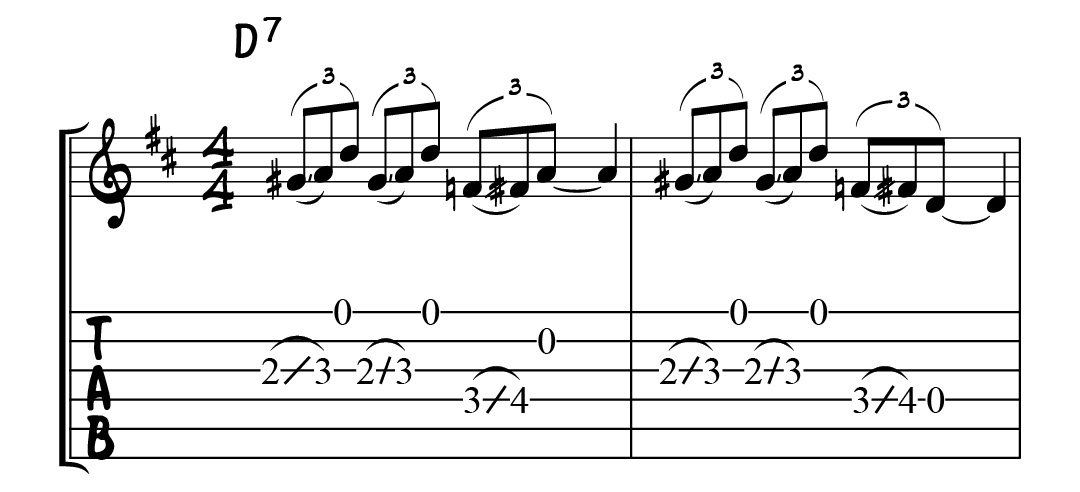
Interested in Open G Tuning? (DGDGBD) Read this post Introduction to Open G Tuning.
Riff Two and Three
The second riff uses a familiar country-blues riff playing the two strings together again with the triplet rhythm and slide:
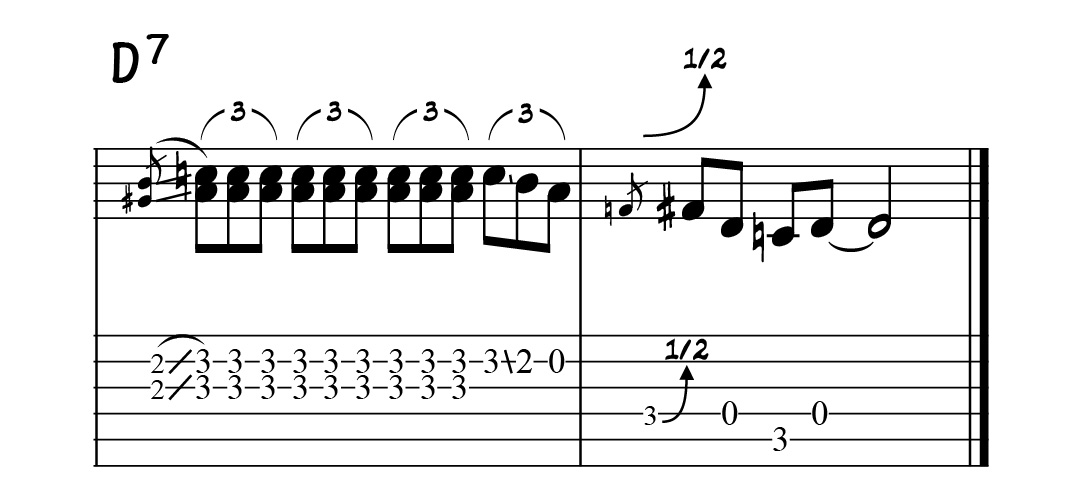
The third riff is a basic blues bass pattern transposed into G to jive with the G chord on bars 5 and 6.
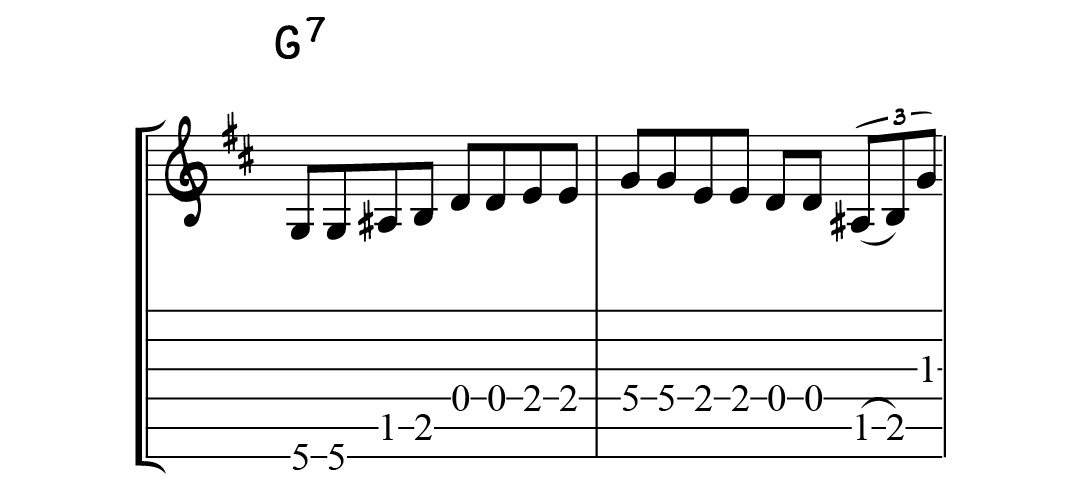
Putting the Solo Together
That’s pretty much it for the riffs. All you have to do is repeat riff #1 in bars 7, and 8 then transpose the blues bass riff #3 into the key of A for bar 9. Following the standard 12 bar blues progression, bar 10 returns to the G, where we repeat riff #3 again.
The last two bars simply repeat the first riff #1 again. Repeating riffs is a standard way of creating blues solos and helps create a unified and cohesive solo.
Want to learn 36 major chords in Open D Tuning? Check this post out here.
12 Bar Blues Solo in D
Here is the video with the riffs and complete solo on a 12 bar blues progression in the key of D. The sheet music and audio with the backing tracks are below. Click here to download the free guitar tab PDF.
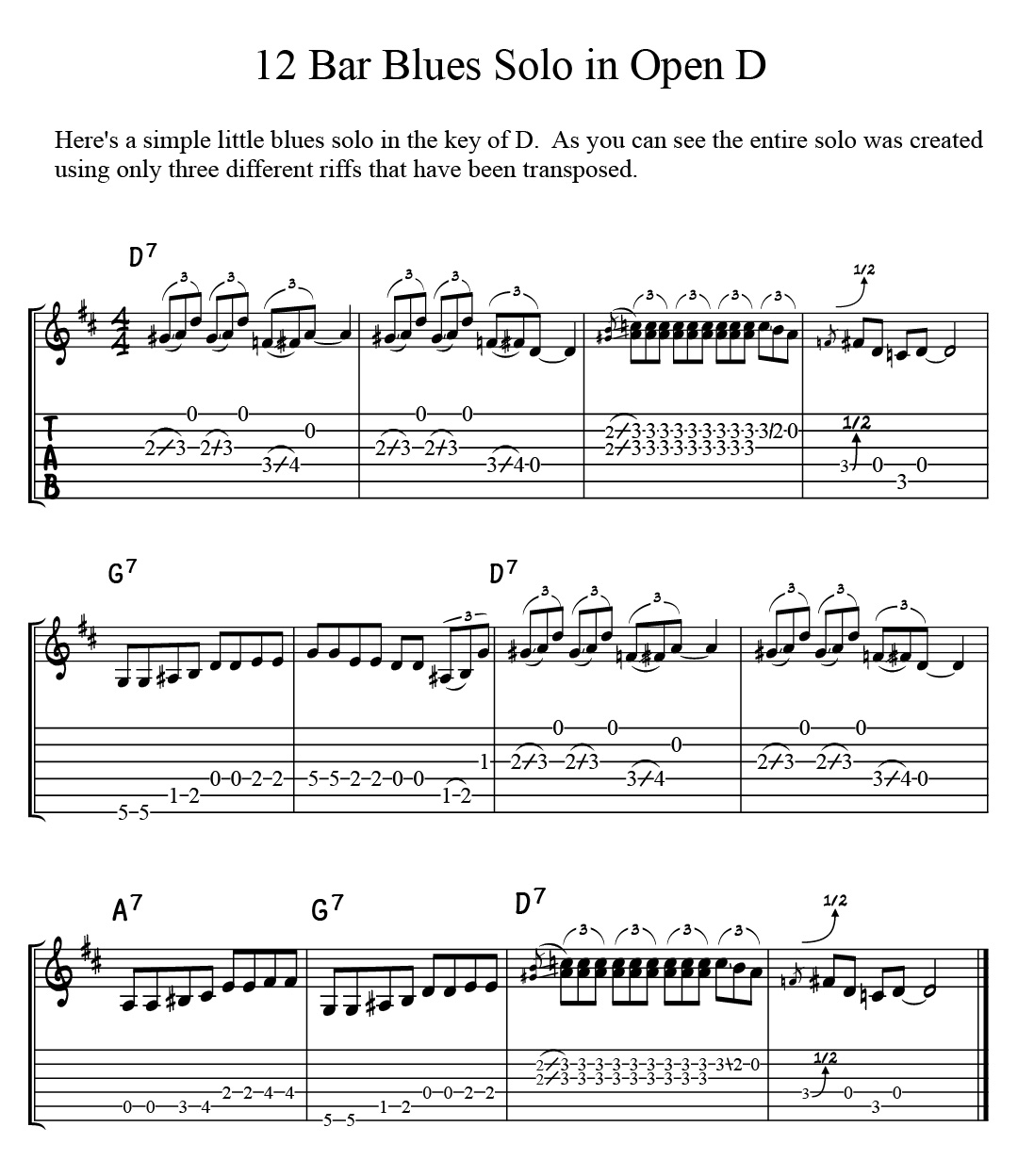
Blues Solo Review and Tips
Let’s review how to create a simple 12 bar solo.
First, you create a short little melodic riff using the notes from the blues scale. Feel free to go outside the blues scale by adding extra notes, not in the scale. Particularly the 3rd of the chord. In a D chord, the 3rd is an F#. Notice the F# is not in the D minor blues scale. You can borrow from the D major blues scale or just think of the 3rd of the chord and target that note.
Second, create at least 2 or 3 more riffs that compliment the first riff. Using a few basic techniques like call and answer, transposition, or contrasting riffs, you can do this. Notice all the riffs are quite different but, when added together, create interest by not being overly repetitive.
Third, make the riffs fit the chords you are playing over. This is done by transposing the riffs to different frets to coincide with the chords of the 12 bar blues progression.
Three More Quick Tips for Guitar Solos
And that’s it! Many students get freaked out when I ask them to do a solo but keep these final three points in mind:
- – Learn the blues scale in the key you are improvising.
- – Make a short, memorable 1 or 2 bar riff.
- – Repeat, repeat, and repeat (sometimes with a bit of variation to keep it fresh).
Good luck jamming! Leave any comments or suggestions you have below.
101 Blues Riffs and Solos in Open D Guitar Tuning
Take your Open D guitar playing to the next level with “101 Blues Riffs & Solos in Open D Guitar Tuning.” The most complete instructional book ever written exclusively in DADF#AD tuning. Using a combination of slide, fingerstyle and pick playing, you will cover all the bases needed to develop a solid technique in open D guitar. Everything you need to master the blues with essential lessons in DADF#AD guitar tuning!
• Master the Blues in Open D Guitar Tuning
• Slide, Fingerstyle and Picking Riff and Solos
• Traditional, Delta, Rock, Funk and Jazz Blues
• Extensive Scale, Chord, and Arpeggio Charts
• A Complete Course for Open D (DADF#AD)
• Audio Tracks Below
OPEN D (DADF#AD) Guitar Chord and Fingerboard Posters
This two-poster guitar chord set is an excellent reference for creative guitarists exploring the world of altered tunings in Open D tuning (DADF#AD).
The Open D Guitar Christmas Songbook
The Open D (DADF#AD) Guitar Christmas Songbook has thirty-holiday favourites and a 40-page Open D reference with Tab, chords, and more.
Celtic Flatpicking Open D Guitar Tuning
Celtic Guitar Flatpicking in Open D Guitar. Tuning your guitar to DADF#AD or “Open D” tuning compliments Celtic guitar music perfectly. 30+ Celtic session tunes and songs. Jigs, reels, songs, hornpipes, waltzes, plus useful tips for Flatpicking and ornamentation. DADF#AD chords and arpeggios, Celtic strumming patterns, Campanella major, minor and modal scales, plus a DADF#AD fingerboard chart.
Classical Guitar Book in Open D Tuning
45 New Arrangments for Classical Guitar Players in Open D Tuning
• Tablature, Notation, Fingerings, and Performance Markings
• 24 of Giuliani’s right-hand technical exercises arranged for Open D
• Scales, arpeggios and chords to master the fingerboard

